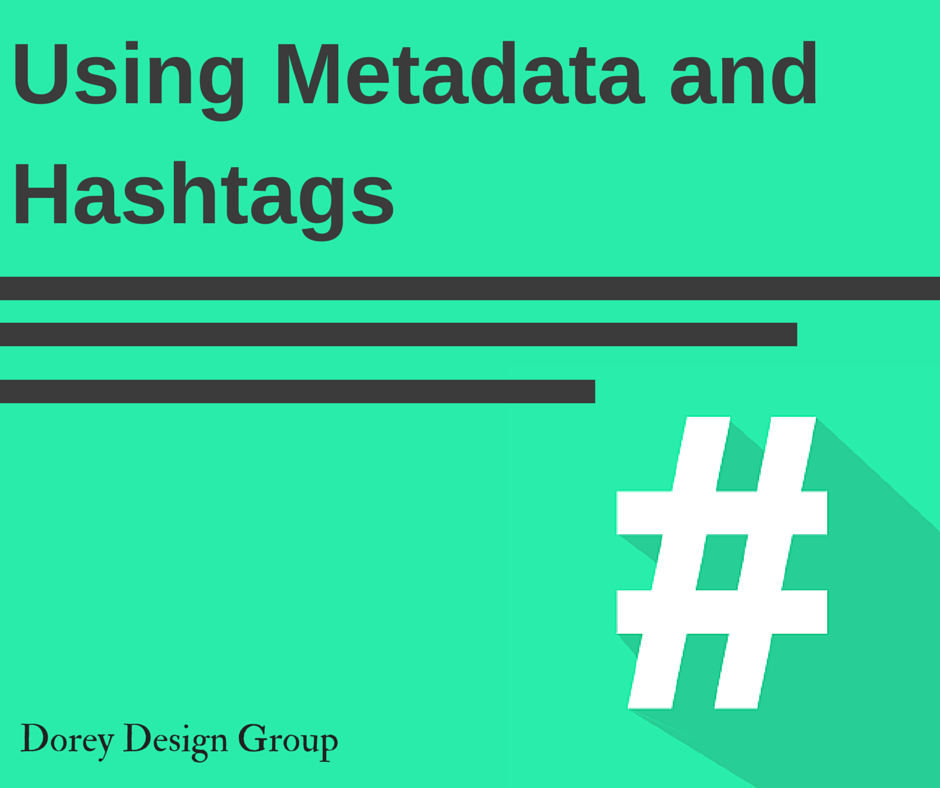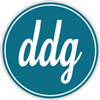Using Metadata and Hashtags
 Metadata is one of those terms many of us might hear often and even use daily, yet not fully understand what it means. In short, metadata is data about data. It helps the search for relevant information and organizes electronic resources. Additionally, metadata provides digital identification, and supports the archiving and preservation of electronic resources. There are two types of metadata that you need to be aware of. The first is structural metadata, which data about the design and specifications of data structures. To put that in another way, it is the data about the functions, shapes, colors, and layouts of things that hold the content you see online. There is also descriptive metadata, which is data bout individual instances of data or data content. This is the data that fills data structures. This can be website copy, images, blog articles, etc.
Metadata is one of those terms many of us might hear often and even use daily, yet not fully understand what it means. In short, metadata is data about data. It helps the search for relevant information and organizes electronic resources. Additionally, metadata provides digital identification, and supports the archiving and preservation of electronic resources. There are two types of metadata that you need to be aware of. The first is structural metadata, which data about the design and specifications of data structures. To put that in another way, it is the data about the functions, shapes, colors, and layouts of things that hold the content you see online. There is also descriptive metadata, which is data bout individual instances of data or data content. This is the data that fills data structures. This can be website copy, images, blog articles, etc.
Metadata is a way of organizing information in a way that is simple and grouped in a logical manner. The reason that understanding and using metadata is important is that it’s what search engines use to find your website. Properly tagging and describing your content is important to increase your search engine optimization and get found by potential customers!
► Website not looking or working right?
► Tell us about it.
The usage of metadata can actually be tracked back before the internet! When libraries needed a way to identify locations, subjects, and specific instances of their books, they used card catalogs to help them organize and find the books (information) in the library. With the advent of the digital age, metadata became a way to describe digital data. Metadata’s function once again evolved with Web 2.0. While metadata exists in the same form, end users/consumers use hashtags (pound symbol/number sign) to find related content to consume. This has greatly democratized the distribution of information and content across the internet and has been revolutionary in the sense that now anyone can be a publisher/content creator and distributor.
As digital consumers ourselves, we are very familiar with the hashtag (#), a type of metadata that describes groups of related content. Hashtags are chosen by the content creator, informally, and when many content creators use the same hashtags, groupings of similar content are formed. Twitter was the one of the first platforms to use this, with Instagram and now even Facebook (click here for tips on how to run a Facebook Page) incorporating hashtags within their social platforms ecosystem. Users find related content using these hashtags, and even create communities around these different groupings. For example, if there was a Bruno Mars concert in Portland one night, users would post tweets and pictures on twitter with #BrunoMarsPDX. As more and more users use that hashtag, a user could browse other tweets/pictures on Twitter with that hashtag and share their concert experience with others.
As a business, utilizing hashtags appropriately will contribute positively for creating brand excitement and increasing your brand’s reach. Because hashtags on social media platforms are informally used, there aren’t any strict specifications as to how your business uses hashtags to categorize content, but you should keep in mind that if the hashtag is insensitive, can be misunderstood in any way, or allows too much room for interpretation, users could hijack your hashtag and post brand-inappropriate content. Look no further than the New England Patriot’s Twitter disaster last year.
Tagging your content online with social media hashtags isn’t an exact science and you’re not going to be successful all the time. However, there are some general guidelines to using hashtags effectively and avoid pissing your audience off. It’s usually best practice to add one hashtag to a post, two if you include a location as well, and three at the absolute maximum. Using more in your post can infuriate users, and work against you while building your brand presence on that particular platform. Additionally, you could get your business’ account suspended for over-hashtagging. Twitter warns you that misuse or overuse of hashtags will lead to your account being filtered from search results (bad), or being suspended (worse). Pay attention to trending tags on Twitter and contribute when you have something meaningful to say/it’s brand-appropriate to help boost your reach, and experiment with different types of content to see what gains the most traction with your hashtags.
Some popular hashtags on Twitter, Instagram, and Facebook (not including current trending ones) include:
#mcm: Man Crush Monday- posts mainly about pictures of men in user’s lives that they look up to/admire.
#transformationtuesday: These posts are mainly about before/afters of people undergoing huge changes in their lives (starting a workout regimen for example), but is a great opportunity to showcase how your brand is changing
#wcw: Woman Crush Wednesday- like #mcm, but for girls. With both of these hashtags, they’re a little more personal, so featuring members of your staff every week could be a good idea to engage your community.
#tbt: Throwback Thursday- Posts usually consist of pictures, events, things from the past. Had an awesome event last year? Post a #tbt to Twitter and Instagram!
#FridayNight: Generic, and popular. This tag can be used to post about things happening with the office that night, the weekend coming, the office going out for drinks (if brand-appropriate). There’s lots of flexibility with this one, but keep in mind that most of the posts by other users will be them going out and having fun after the work week has finished.
To see the effect of hashtags on SEO, Google search ‘Apple.’ You’ll come up with Apple the company, but also apple the fruit. On the other hand, searching ‘#Apple’ will show you content and posts of people with their iPhones, Macs, and iPads. Hashtagged content is also less competitive in Google’s search algorithms since there are less results. Your content is more specialized than the general search term ‘Apple,’ so you have a better chance of getting to the top of the search engine stack if you can use hashtags effectively.
More than just using hashtags on social media, using metadata correctly within your website is also very good for SEO. Metadata has democratized the media business because anyone can be a publisher and distribute their content widely and for free! This leads to the long tail effect of content generation, where specialized and engage communities based on content emerge from these groupings. By incorporating detailed meta descriptions, tags in your blog posts, and couple that with a light and responsive website, you’ll increase your organic search greatly.
#Hashtag. This may be the only suitable use for one of the most inane ones I’ve seen online.
Questions or comments about metadata, hashtags, SEO, social media? Contact us!
